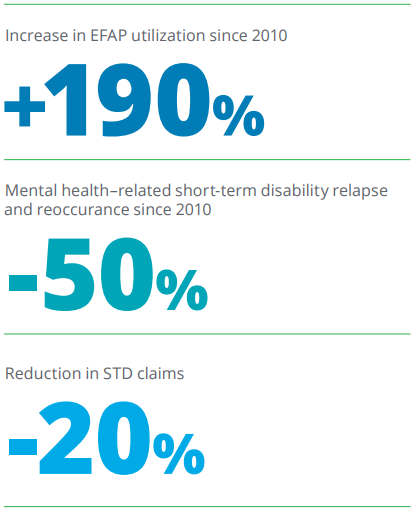“Only one-third of Canadian employers have a mental health strategy in place, and most of those organizations are not yet measuring the outcomes of their investments.” (Deloitte, 2019)
Recognizing the Need for Workplace Mental Health Programs
Deloitte’s 2019 report, The ROI in Workplace Mental Health Programs: Good for People, Good for Business. A Blueprint for Workplace Mental Health Programs, addresses prevalent issues within organizations, such as a lack of trust, bullying, abusive power dynamics, favouritism, discrimination, and unrealistic workloads. These factors contribute to high levels of stress and a decline in staff well-being. The report serves as a call to action, emphasizing the positive impact that workplace mental health programs can have on both individuals and businesses. (Cookman & Young Whyte, 2020)
Implementing Effective Mental Health Programs
To implement effective mental health programs, organizations can leverage established frameworks like Canada's Psychological Health and Safety in the Workplace national standard. These frameworks can help companies map existing programs for their efficacy in promoting mental health and preventing psychological harm to work towards continuously improving workplace environments and identifying any gaps and areas that need additional investment. Based on this analysis, existing programs can possibly be enhanced, eliminating the need to start from scratch. For a detailed breakdown of mental health program implementation, refer to Figure 11 from the Deloitte report. (Deloitte, 2019)
Measuring Success & Demonstrating ROI
To measure the success of mental health initiatives, companies need to identify meaningful key performance indicators (KPIs), goals, objectives, and targets. By formalizing these metrics, organizations can assess progress, track outcomes, and demonstrate the return on investment (ROI) in data-driven terms. Regularly measuring KPIs and ROI is essential for sustaining progress and achieving desired outcomes. By tracking outcomes, organizations can illustrate the financial and nonfinancial benefits of mental health programs, which in turn strengthens stakeholder buy-in.
Figure 1: Key Metrics at Bell

Source: Bell Canada
Figure 1 provides an example of KPIs used at Bell such as the utilization of Employee and Family Assistance Programs (EFAP) and Short-Term Disability (STD) claims and relapse and reoccurrences. (Deloitte, 2019)
Key Factors for Success
Several factors are critical to the success of mental health programs. These include prioritizing proactive programs that span the entire mental health spectrum from prevention to treatment, prioritizing investments in high-impact areas at both the leadership and employee levels (especially when resources are limited), recognizing the impact of poor mental health as a top cost driver, linking workplace mental health to organizational objectives, and utilizing data analysis to inform program adjustments based on evolving employee needs and expectations. (Deloitte, 2019)
Common Barriers & Overcoming Challenges
Implementing mental health programs can present challenges for organizations. Difficulties arise in large, complex, and highly decentralized organizations. Change management and integrating mental health initiatives after acquisitions also pose significant hurdles. Additionally, insufficient financial, human, and program resources can impede progress. Recognizing these barriers and addressing them proactively is essential for success. (World Health Organization, 2013)
Mental Health as a Strategic Advantage
Investing in mental health is not only a responsibility but also a strategic advantage for companies in today's business landscape. By following the critical steps of leveraging frameworks, enhancing existing programs, and measuring outcomes, organizations can create a positive work environment that supports mental health. Overcoming common barriers and aligning mental health programs with organizational objectives further enhances the likelihood of success. In 2009, Keys and Lopes (2009) pointed out that “science has produced effective treatments for more broken-down people but remains ineffective at preventing more people from breaking down.” It’s been 14 years; it's time to strive towards making that statement irrelevant.
Bibliography
Cookman, A., & Young Whyte, G. K. (2020). Integrating individual and organizational well-being (SSIR). Retrieved from https://ssir.org/articles/entry/integrating_individual_and_organizational_well_being?utm_source=Enews&utm_medium=Email&utm_campaign=SSIR_Now
Deloitte. (2019). The ROI in Workplace Mental Health Programs: Good for People, Good for Business. A Blueprint for Workplace Mental Health Programs. Deloitte Insights.
Keyes, C. L., & Lopez, S. J. (2009). Toward a science of mental health. Oxford handbook of positive psychology, 2, 89-95.
World Health Organization. (2013). Investing in mental health: evidence for action.